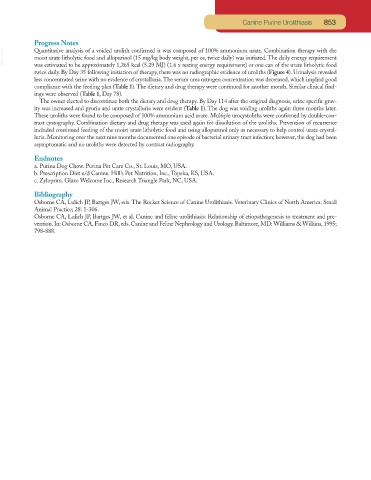Page 823 - Small Animal Clinical Nutrition 5th Edition
P. 823
Canine Purine Urolithiasis 853
Progress Notes
VetBooks.ir Quantitative analysis of a voided urolith confirmed it was composed of 100% ammonium urate. Combination therapy with the
moist urate litholytic food and allopurinol (15 mg/kg body weight, per os, twice daily) was initiated. The daily energy requirement
was estimated to be approximately 1,265 kcal (5.29 MJ) (1.6 x resting energy requirement) or one can of the urate litholytic food
twice daily. By Day 35 following initiation of therapy, there was no radiographic evidence of uroliths (Figure 4). Urinalysis revealed
less concentrated urine with no evidence of crystalluria.The serum urea nitrogen concentration was decreased, which implied good
compliance with the feeding plan (Table 1).The dietary and drug therapy were continued for another month. Similar clinical find-
ings were observed (Table 1, Day 78).
The owner elected to discontinue both the dietary and drug therapy. By Day 114 after the original diagnosis, urine specific grav-
ity was increased and pyuria and urate crystalluria were evident (Table 1). The dog was voiding uroliths again three months later.
These uroliths were found to be composed of 100% ammonium acid urate. Multiple urocystoliths were confirmed by double-con-
trast cystography. Combination dietary and drug therapy was used again for dissolution of the uroliths. Prevention of recurrence
included continued feeding of the moist urate litholytic food and using allopurinol only as necessary to help control urate crystal-
luria. Monitoring over the next nine months documented one episode of bacterial urinary tract infection; however, the dog had been
asymptomatic and no uroliths were detected by contrast radiography.
Endnotes
a. Purina Dog Chow. Purina Pet Care Co., St. Louis, MO, USA.
b. Prescription Diet u/d Canine. Hill’s Pet Nutrition, Inc., Topeka, KS, USA.
c. Zyloprim. Glaxo Welcome Inc., Research Triangle Park, NC, USA.
Bibliography
Osborne CA, Lulich JP, Bartges JW, eds. The Rocket Science of Canine Urolithiasis. Veterinary Clinics of North America: Small
Animal Practice; 28: 1-306.
Osborne CA, Lulich JP, Bartges JW, et al. Canine and feline urolithiasis: Relationship of etiopathogenesis to treatment and pre-
vention. In: Osborne CA, Finco DR, eds. Canine and Feline Nephrology and Urology. Baltimore, MD: Williams & Wilkins, 1995;
798-888.

